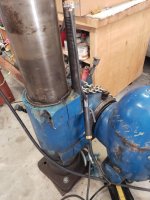So...as I continue to try to resurrect the Voest drill press that no one loves but me, I have discovered the vertical acme thread-screw that is used to raise and lower the head is stuck.
This is odd, as the drill appears to be well lubricated...no rust. But the screw is stuck dead solid....I can put a 24" pipe wrench in it and it won't budge even a bit. I've run some Kroil down the screw for about a day, still no luck.
I decided to try putting some heat in the screw. I connected my Miller 180SD TIG welder in the arc welder mode. Positive polarity on the electrode side, and the ground is negative I must assume.
I turned it on and dialed up the amps all the way to 180.....the top lead (electrode) stays at 84F room temperature. The bottom lead (ground clamp) does get up to about 130F. The screw itself also shows no temp rise at all.
I suspect the answer is I don't have enough welder. But not sure. Also, why is the positive side showing zero temp rise while the ground is at least picking up 45F?

This is odd, as the drill appears to be well lubricated...no rust. But the screw is stuck dead solid....I can put a 24" pipe wrench in it and it won't budge even a bit. I've run some Kroil down the screw for about a day, still no luck.
I decided to try putting some heat in the screw. I connected my Miller 180SD TIG welder in the arc welder mode. Positive polarity on the electrode side, and the ground is negative I must assume.
I turned it on and dialed up the amps all the way to 180.....the top lead (electrode) stays at 84F room temperature. The bottom lead (ground clamp) does get up to about 130F. The screw itself also shows no temp rise at all.
I suspect the answer is I don't have enough welder. But not sure. Also, why is the positive side showing zero temp rise while the ground is at least picking up 45F?




